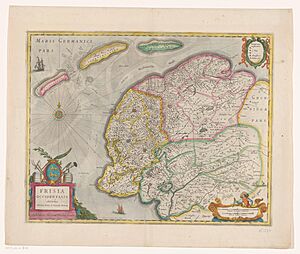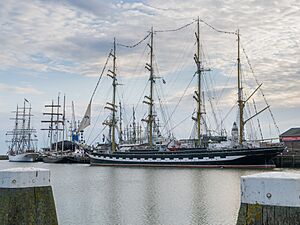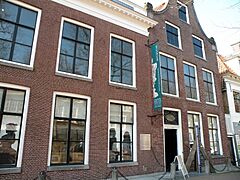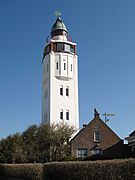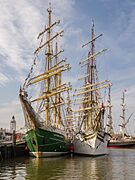Harlingen, Netherlands facts for kids
Quick facts for kids
Harlingen
Harns (West Frisian)
|
|||
|---|---|---|---|
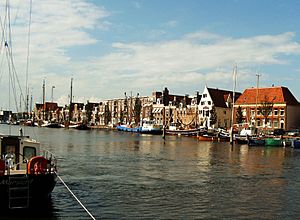
Zuiderhaven Harbor, Harlingen
|
|||
|
|||

Location in Friesland
|
|||
| Country | Netherlands | ||
| Province | Friesland | ||
| Government | |||
| • Body | Municipal council | ||
| Area | |||
| • Total | 387.67 km2 (149.68 sq mi) | ||
| • Land | 25.03 km2 (9.66 sq mi) | ||
| • Water | 362.64 km2 (140.02 sq mi) | ||
| Elevation | 2 m (7 ft) | ||
| Population
(May 2014)
|
|||
| • Total | 15,769 | ||
| • Density | 630/km2 (1,600/sq mi) | ||
| Demonym(s) | Harlinger | ||
| Time zone | UTC+1 (CET) | ||
| • Summer (DST) | UTC+2 (CEST) | ||
| Postcode |
8857–8872
|
||
| Area code | 0517 | ||
Harlingen (Dutch: [ˈɦɑrlɪŋə(n)]; West Frisian: Harns [hãːs]) is a municipality and a city in the northern Netherlands. It is located in the province of Friesland. Harlingen is known for its long history as a port city.
Contents
Harlingen's Location and Features
A Busy Harbor
Harlingen sits on the coast of Friesland, right next to the Wadden Sea. This special location means it has natural waterways that ships can use. Because of this, Harlingen has always been a very important port town. Even though large sailing ships can now easily reach Harlingen, it was harder in the past.
A Great Place for Tourists
The center of Harlingen is full of old, beautiful buildings. The whole area is actually protected because of its historical importance. Harlingen is also a hub for many old sailing ships that offer tours. These things, plus its location on the Wadden Sea, make Harlingen a popular spot for tourists in Friesland. The city is working to make it even better for visitors.
Getting Around Harlingen
Harlingen has two train stations on the railway line that goes to Leeuwarden. If you want to visit the Wadden islands of Vlieland and Terschelling, you can catch a ferry from Harlingen.
Harlingen's History
From Medieval Times
Harlingen has a long history of fishing and shipping. It is believed to have received city rights (special permissions for a town to govern itself) even before it had protective walls. In 1462, a big fire destroyed most of the settlement.
Harlingen was involved in the Vetkopers and Schieringers wars, which were conflicts between different groups in Friesland. In 1496, the people of Franeker attacked and took over Harlingen. Later, in 1498, a duke named Albert III, Duke of Saxony arrived in Harlingen. He helped build a new castle, which led to the city getting stronger defenses.
The Early Modern Period (1500–1800)
Harlingen grew a lot during this time. In 1543, the city expanded its fortified area for the first time. Many people seeking religious freedom, especially Mennonites, moved to Harlingen during the Eighty Years' War (1566–1648). This led to a second big expansion in 1579 and 1580. The village of Almenum became part of the city.
In 1597, the city expanded again. The old city walls were taken down, and new, stronger defenses were built. These new defenses included five bastions (parts of a fort that stick out) and could even flood the surrounding land to protect the city.
In 1645, the Admiralty of Friesland moved to Harlingen. An admiralty was like a naval headquarters that managed ships and trade. Harlingen became a very important center for sea activities.
After the Reformation, Harlingen had several churches for different Christian groups. There was a town hall, a weigh house (where goods were weighed for trade), and a building for grain trading. The town also had a Latin school and a place for poor children.
By the late 1700s, Harlingen was the second-largest city in Friesland, with about 7,500 people. Its economy relied heavily on trade. Ships brought in goods like grains, timber, and wine from places like the Baltic Sea. These goods were then sent throughout Friesland and to the province of Groningen.
Harlingen also exported many products, including butter, cheese, peas, beans, horses, and cattle. Animals were shipped from Harlingen to other parts of the Netherlands and even to other countries.
The city also had industries. People made sails, fabrics, and yarn. Salt was produced nearby, and there were factories for roof tiles and dishes. These industries used peat (a type of fuel) that could be easily brought to Harlingen by water. Fishing was also a steady way for people to earn a living.
Harlingen's success as a port was due to a few things. First, there were natural waterways in the Wadden Sea that connected to the city. Second, the harbor was improved with new docks and outer harbors. This made Harlingen a true port. However, very heavily loaded ships often had to transfer some of their cargo before entering the main harbor.
Third, Harlingen controlled the water levels in the canals of the region. The most important canal was the Harlingertrekvaart, which connected Harlingen to Franeker and Leeuwarden. In the 1640s, a towpath was built along this canal. This allowed for regular and reliable transport of goods and people to and from the city's surrounding areas. By the 1700s, there was even a daily boat connection between Harlingen and Amsterdam.
The 19th Century
Harlingen's port remained important in the 1800s. Steamships began to play a big role. In the 1820s, a steamship company made Harlingen a stop on its Amsterdam-Hamburg route. Steamships made it easier to export farm products, especially to England. This was very important for Friesland's economy. Shipping companies competed to transport goods like live cattle, which could now be shipped more easily.
The Harlingen–Nieuweschans railway was built between 1863 and 1868. This railway connected Harlingen to other parts of the Netherlands even before larger cities like Leeuwarden and Groningen had their own connections to the south. This shows how important Harlingen's harbor was.
The famous Dutch writer Simon Vestdijk was born in Harlingen. He often wrote about his hometown in his books, calling it Lahringen.
Did you know that the town of Harlingen, Texas, in the United States, is named after this city? Many of the first people who settled in the Texas town came from Harlingen in the Netherlands.
Areas of Harlingen
- Harlingen (West Frisian: Harns)
- Midlum (Mullum)
- Wijnaldum (Winaam)
Notable People from Harlingen
- Simon Frisius (c.1570–75 – c.1628/29) a Dutch engraver.
- Maarten Gerritszoon Vries (1589–1647) Dutch cartographer and explorer.
- Sebastiaen Jansen Krol (1595–1674) Director of New Netherland 1632/1633.
- Jacob Adriaensz Backer (1609–1651) a Dutch Golden Age painter.
- Tako Hajo Jelgersma (1702–1795) a Dutch painter.
- Jacobus Deketh (1726–1764) a captain in the Frisian Admiralty.
- Joannes de Mol (1726–1782) a Dutch minister and porcelain maker.
- Hermanna Molkenboer-Trip (1851–1911) a Dutch industrialist.
- Court Lambertus van Beyma (1753–1820) a public notary and delegate of the States of Friesland.
- Nicolaas Baur (1767–1820) was a Dutch marine artist.
- Johannes Kayser (1842–1917) a Dutch architect, mostly of churches.
- J.J.L. Duyvendak (1889–1954) a Dutch expert in Chinese studies and professor.
- Simon Vestdijk (1898–1971) a Dutch writer, nominated 15 times for the Nobel prize in literature.
- Peter J Sterkenburg (1955–2000) a Dutch self-taught painter of sea scenes.
- Jan Ykema (born 1963) a former ice speed skater, who won a silver medal at the 1988 Winter Olympics.
- Abe de Vries (born 1965) a Frisian poet, essayist, critic, journalist, editor, translator, and photographer.
- Joost Vandebrug (born 1982) a Dutch photographer, video director, and documentary film director.
Images for kids
Gallery
See also
 In Spanish: Harlingen (Frisia) para niños
In Spanish: Harlingen (Frisia) para niños





